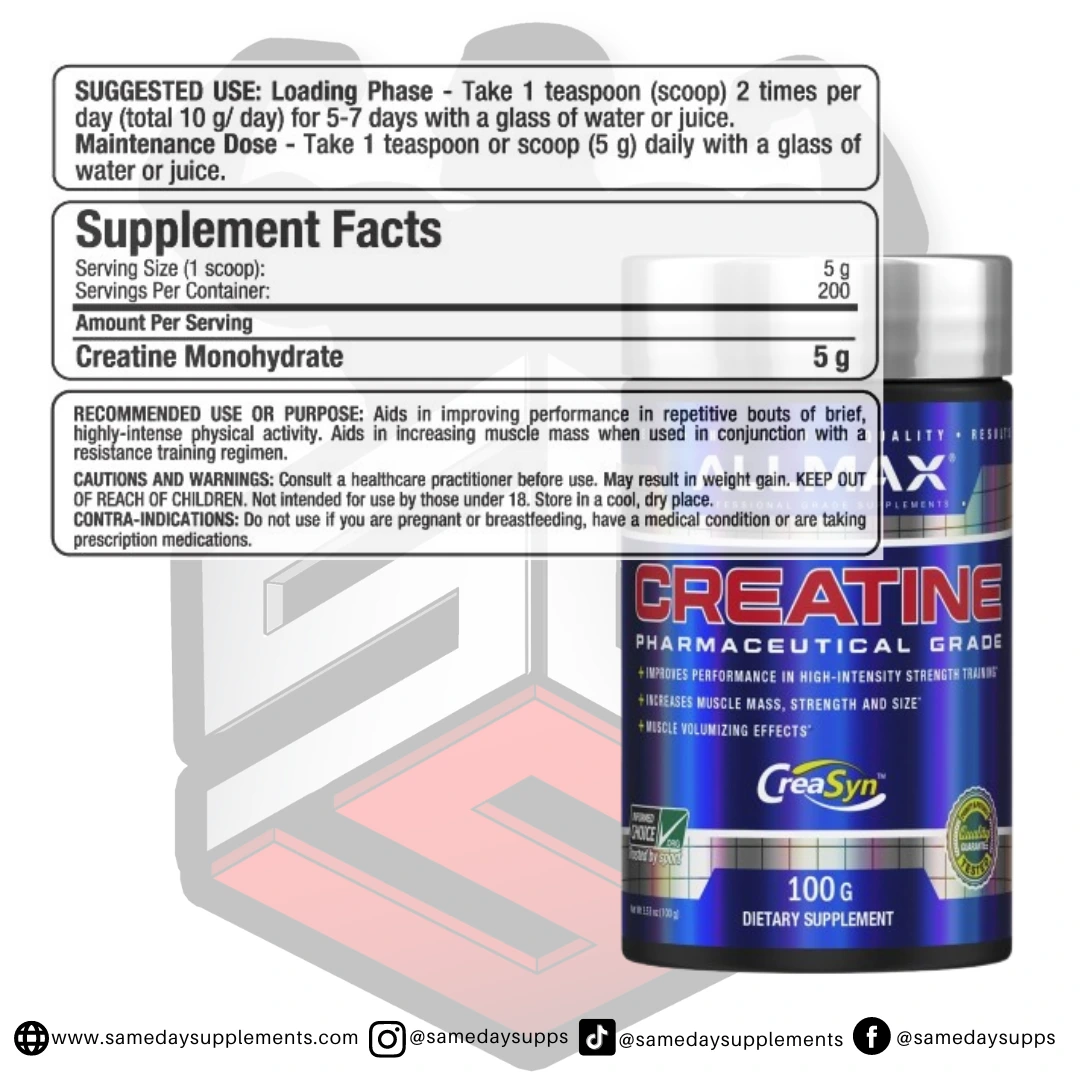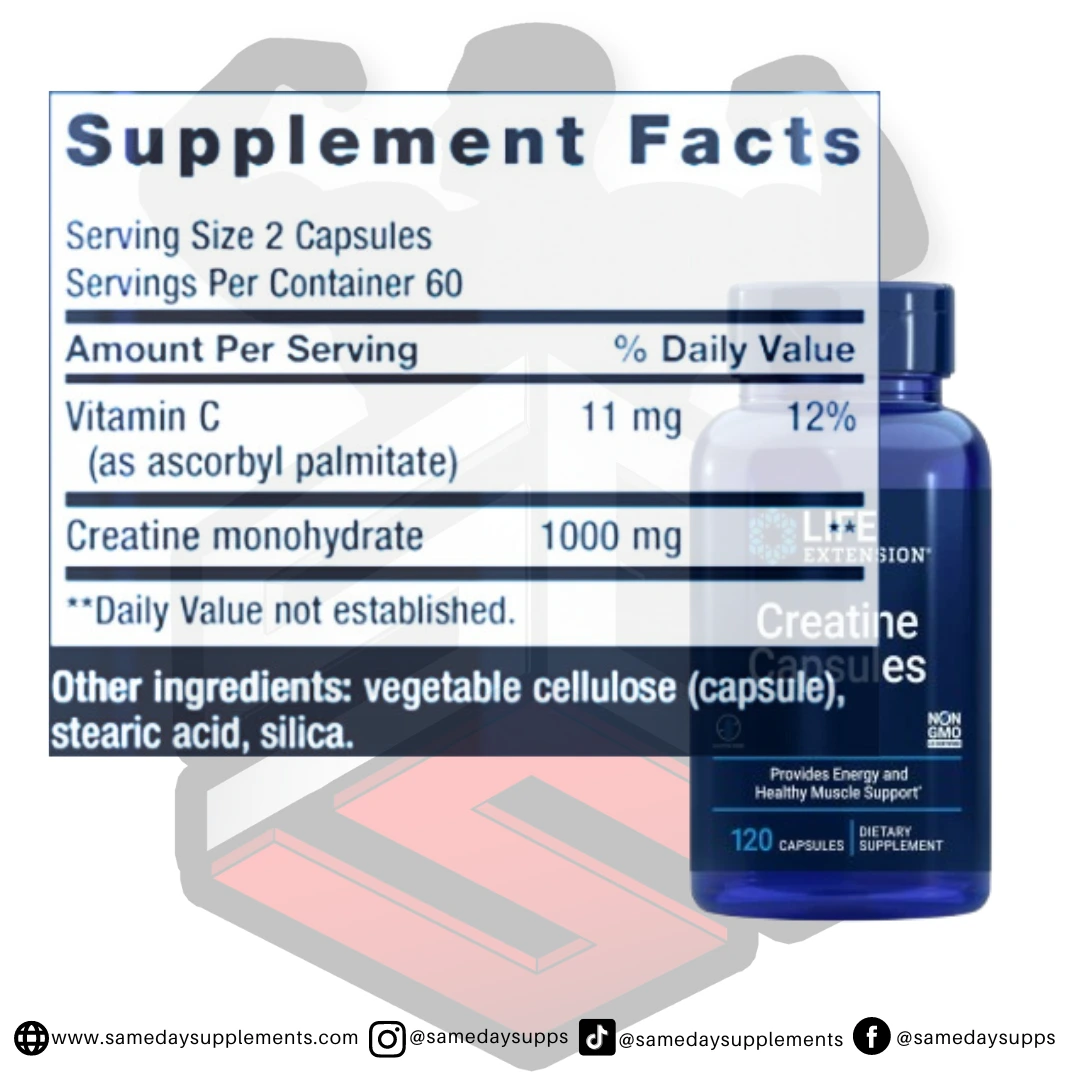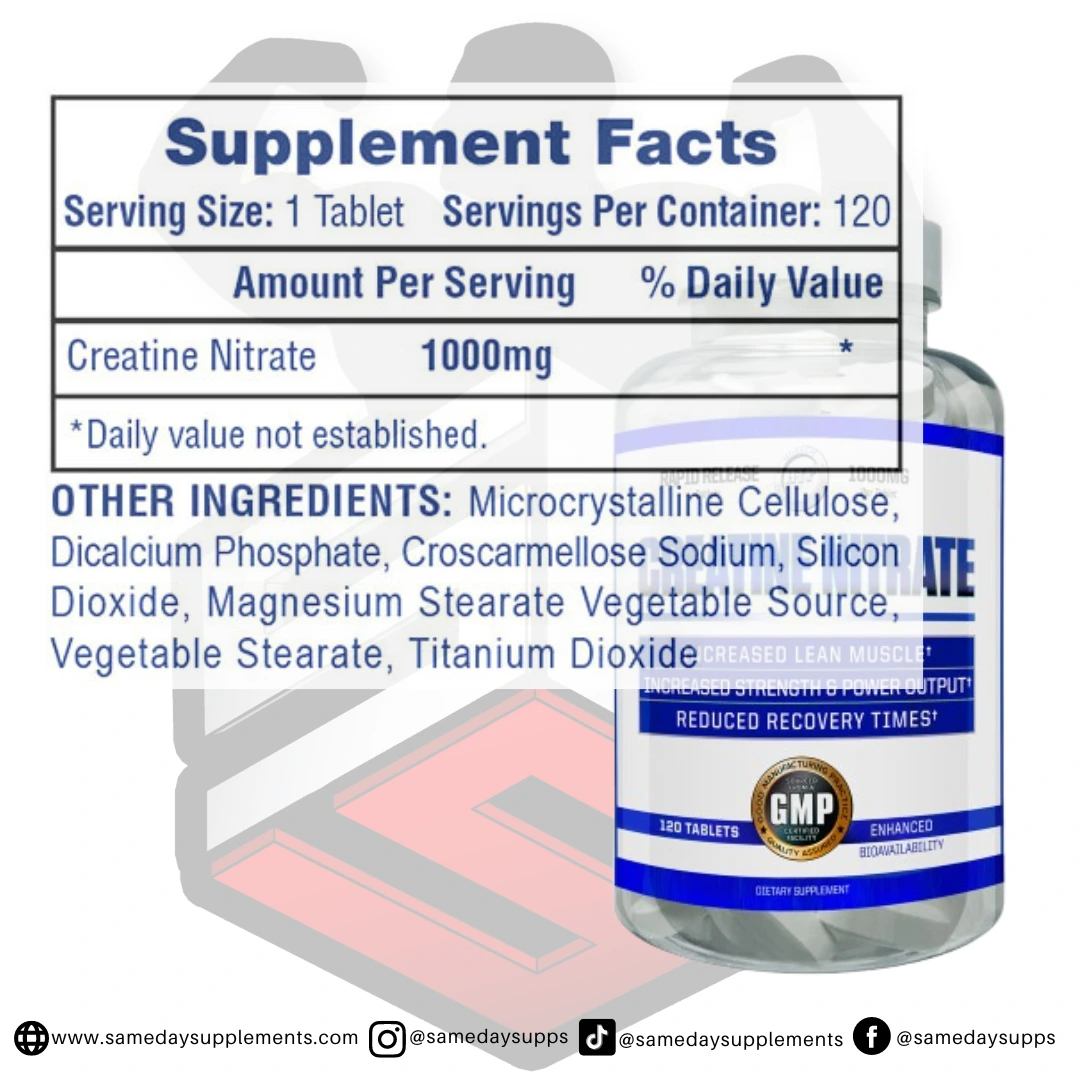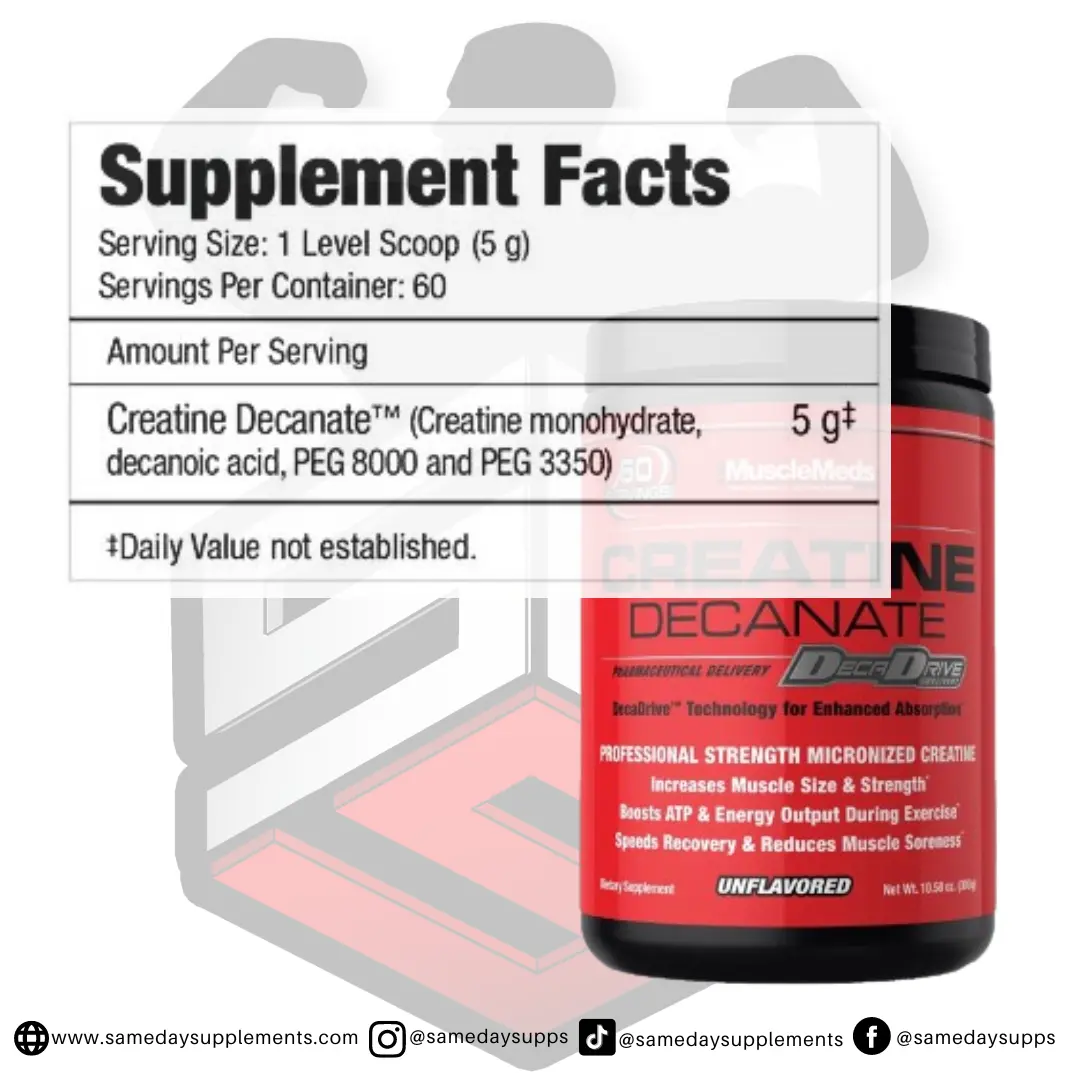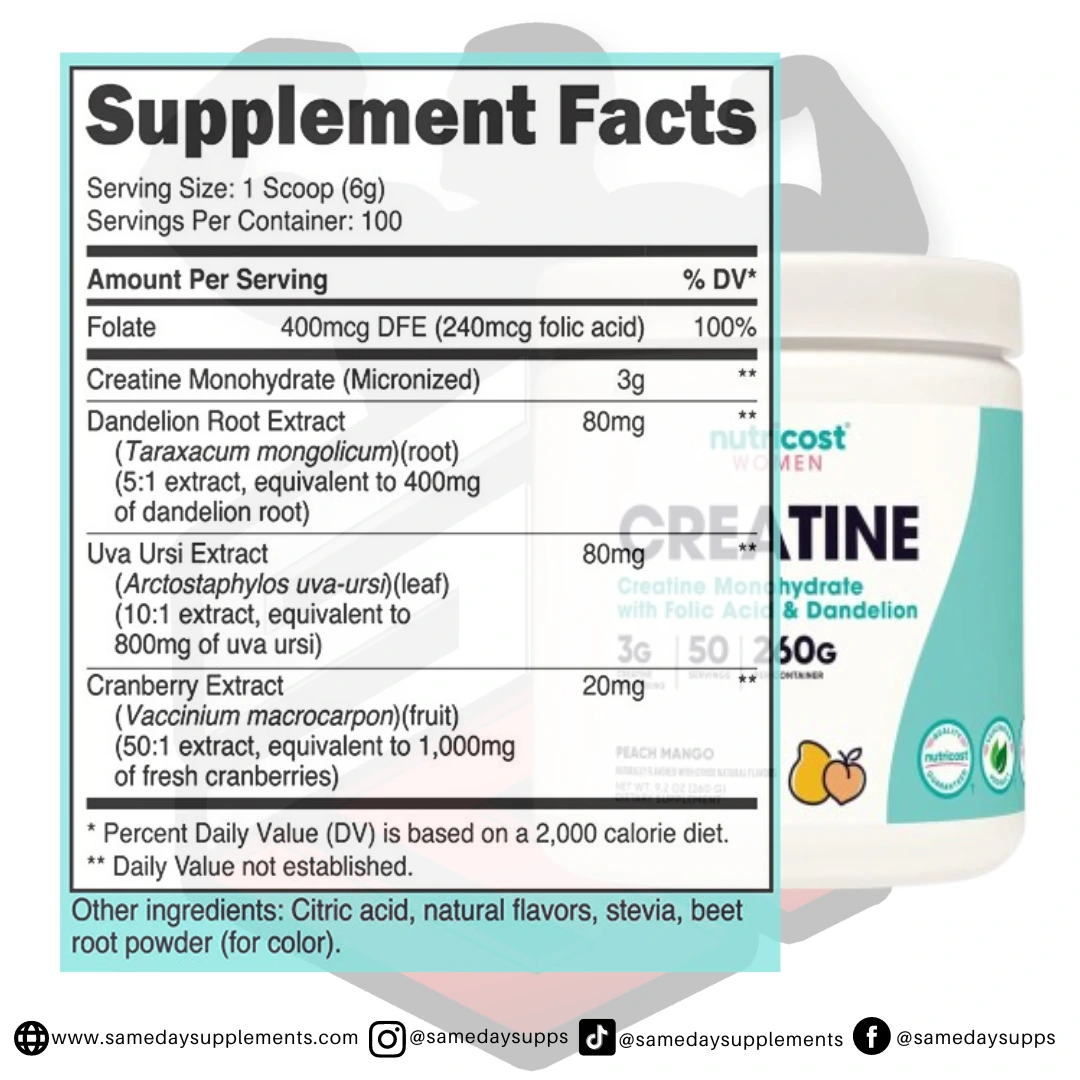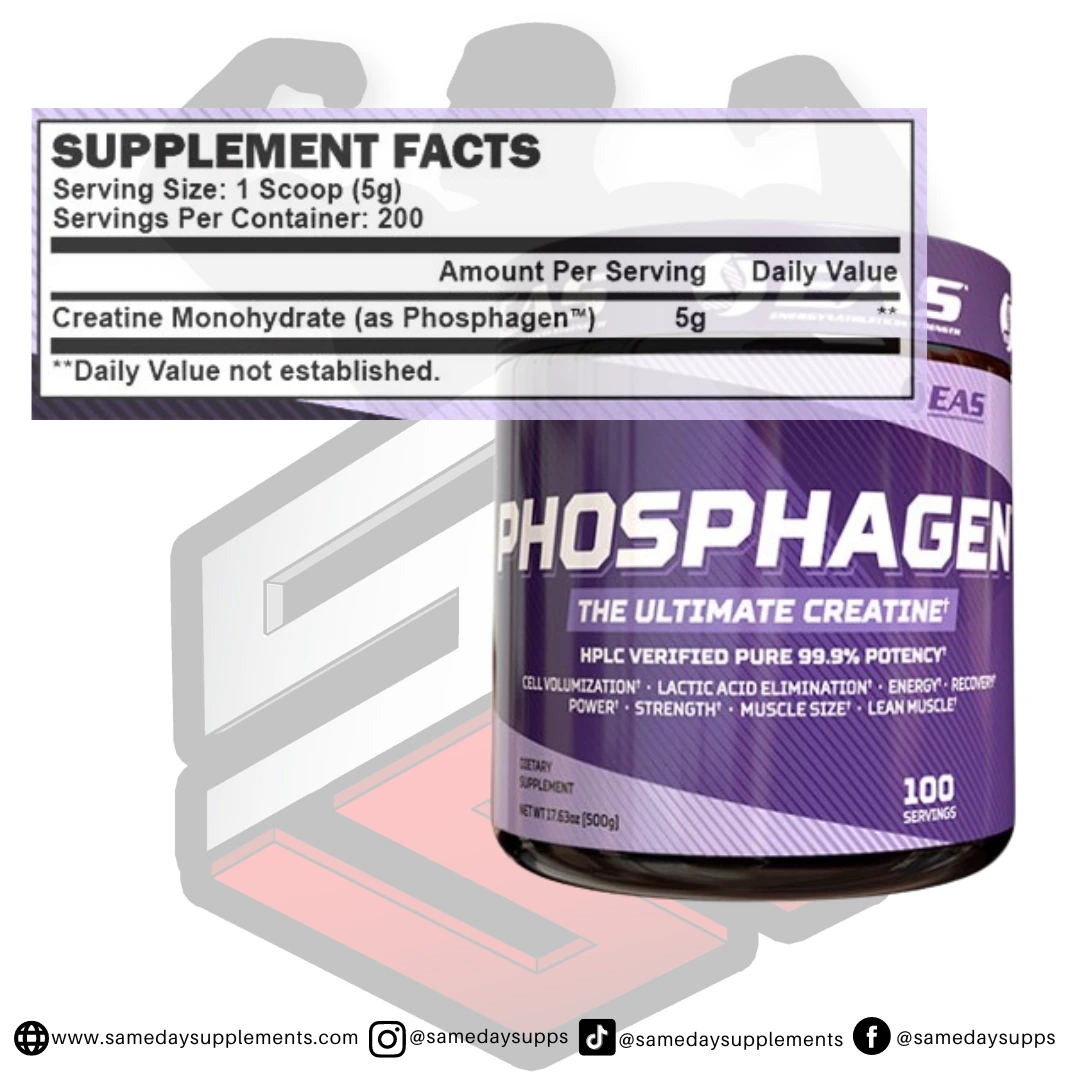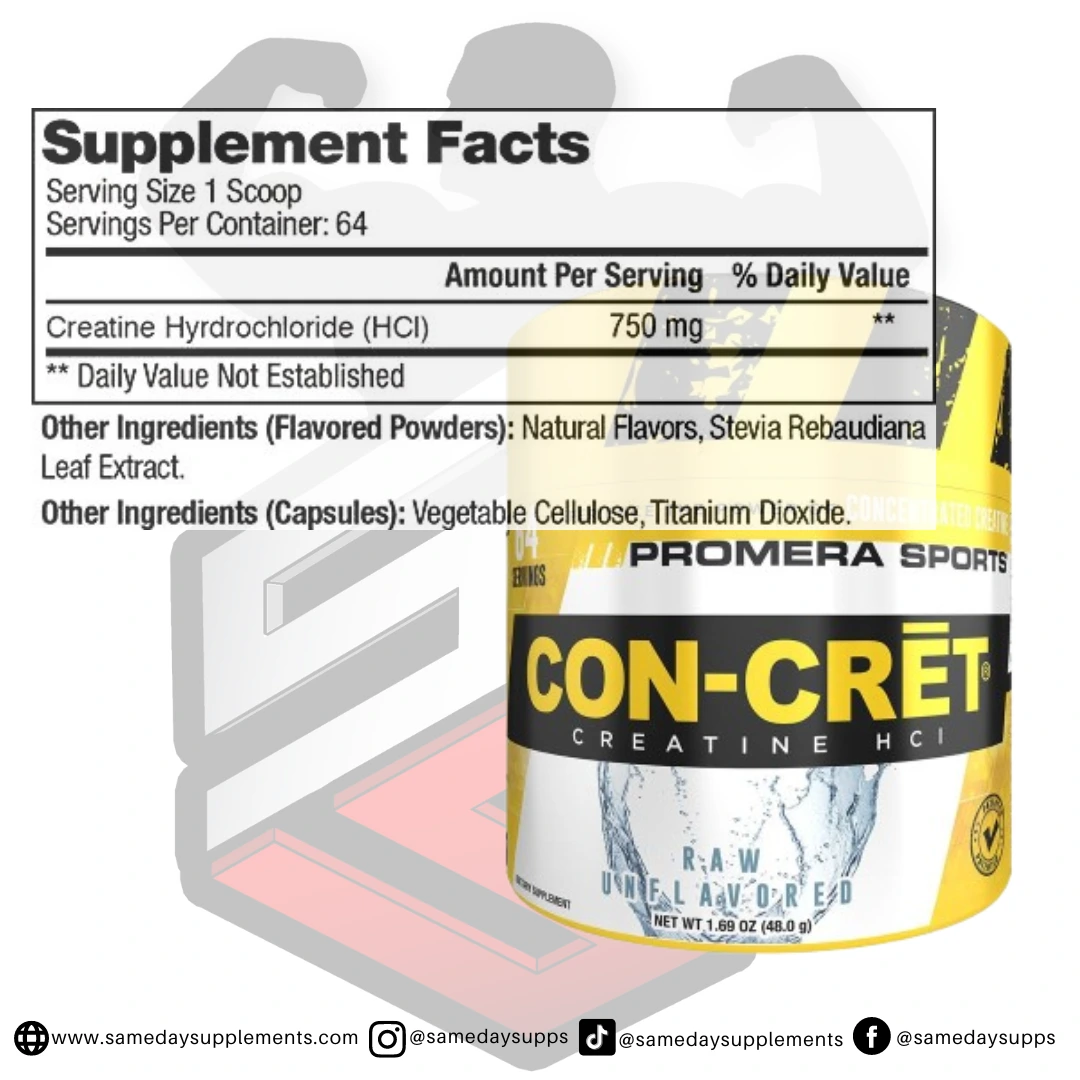What Is Creatine | How Does Creatine Work | Benefits | FAQ | Myths | Popular Products | Warnings And Side Effects | References | Disclaimer
Over the years, Creatine has become one of the most popular and widely used performance-enhancing supplements in sports and fitness. This organic acid plays a crucial role in providing energy to muscles and has been shown to improve athletic performance, increase muscle strength and endurance, and accelerate muscle growth. This blog will take a closer look at what Creatine is, how it works, its benefits and risks, and how you can use it effectively in your fitness regimen.
![]()
Contrary to popular misconception, creatine is not a steroid! Instead, it is a naturally occurring substance in small amounts in animal-based foods and is produced by the human body in small quantities. Creatine combines three amino acids; L-arginine, Glycine, and L-Methionine. Our bodies also store creatine as phosphocreatine in the muscles, which can be a source of energy during high-intensity physical activities, such as weightlifting and sprinting.†
This stored phosphocreatine supports short bursts of energy, making it a valuable resource during exercises requiring power and strength. While we naturally store about 95% of our body’s creatine in muscles, it’s difficult to get enough from diet alone to see performance benefits—hence the rise of creatine supplements.†
![]()
![]()
How Does It Work:
In general, creatine can help maintain a continuous supply of energy to working muscles by keeping production up in working muscles.† But before we can understand how it works, we must understand how our body produces and uses energy.
Energy Production Overview:
Carbohydrates are broken down into glucose during digestion, which is further broken into carbon dioxide and water, releasing energy in the form of ATP. ATP fuels muscle contractions but is stored in limited quantities in muscles, so as ATP depletes, physical performance can decline.†
When you supplement with creatine, it increases your muscles’ stores of creatine phosphate. During high-intensity exercises, creatine phosphate donates a phosphate molecule to ADP (adenosine diphosphate), converting it back into ATP. This process replenishes ATP levels, providing more energy for muscle contractions, which helps improve strength, endurance, and exercise performance.†
Over time, the increased ATP availability allows for more intense workouts, which can result in enhanced muscle growth and better overall performance.†
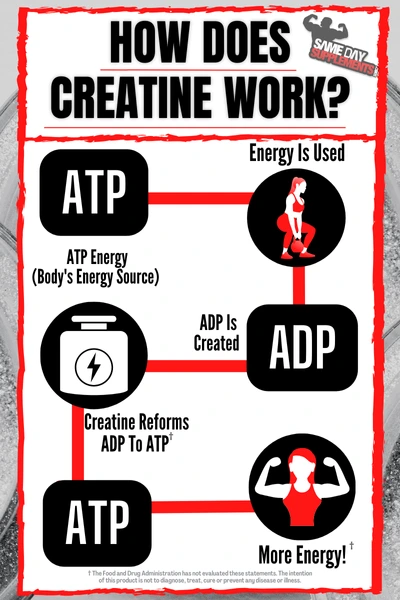

![]()
![]()
Benefits:
Creatine is widely recognized for its role in enhancing athletic performance and muscle growth, but its benefits go beyond just strength training. Here are some key advantages of creatine supplementation:
1. Improved Strength and Power Output:
Creatine is best known for boosting strength and power during short, high-intensity activities like weightlifting, sprinting, and explosive movements. By increasing the availability of ATP (adenosine triphosphate) in muscles, creatine enables you to perform more reps or lift heavier weights, leading to significant strength gains over time. Studies have shown that creatine supplementation can improve maximal strength and power output, particularly in resistance training.†
2. Enhanced Muscle Growth:
By facilitating greater workout intensity and volume, it indirectly promotes muscle hypertrophy (growth). When combined with regular strength training, creatine supplementation can lead to noticeable increases in lean muscle mass. This is partly due to creatine’s ability to increase water content in muscle cells, creating a favorable environment for protein synthesis and muscle repair. This increased hydration can also make muscles appear fuller.†
3. Accelerated Recovery:
Creatine enhances workout performance and aids in recovery after strenuous exercise. Supplementing with creatine can reduce muscle cell damage and inflammation, speeding up the recovery process between workouts. This allows athletes to train harder and more frequently without experiencing excessive soreness or fatigue.†
4. Increased Cell Hydration:
Creatine draws water into muscle cells, increasing cell volume or muscle “swelling.” While some mistake this for water retention, cellular hydration actually plays a vital role in muscle growth by enhancing nutrient delivery and metabolic efficiency. This hydration effect helps promote muscle repair and overall cell health, making it easier for the body to recover and grow.†
5. Reduction in Protein Breakdown:
It helps prevent muscle breakdown by reducing protein levels. It is called myostatin, and it can inhibit muscle growth. Lowering myostatin levels allows the body to build more muscle. Additionally, creatine reduces muscle protein degradation, preserving muscle mass and promoting growth, especially in individuals undergoing intense training.†
6. Boosted Exercise Performance:
Athletes who take creatine typically experience improvements in high-intensity exercise performance, including increased endurance during short-duration activities like sprinting and resistance training. This boost comes from creatine’s ability to replenish ATP stores quickly, allowing for sustained performance during repeated bouts of intense physical activity. Studies show that athletes using creatine outperform those who don’t in various types of sports.†
7. Support for Brain Health:
Recent research suggests that it may also have neuroprotective effects, improving cognitive function and protecting the brain from injury or degenerative conditions. Creatine supports brain health by replenishing ATP in brain cells, potentially aiding memory, focus, and mental clarity. Some studies indicate that supplementation can enhance cognitive performance, particularly in tasks requiring short-term memory or quick thinking.†
8. Improved Anaerobic Performance:
Creatine is especially effective for anaerobic activities, which rely on short bursts of energy. This includes activities like weightlifting, sprinting, and other explosive movements. Creatine enhances your body’s capacity for anaerobic energy production, allowing you to push harder in the gym and improve overall athletic output.†
9. Reduced Fatigue:
Improving the replenishment of ATP stores helps combat fatigue during both workouts and recovery periods. Athletes taking creatine report feeling less exhausted after strenuous sessions, which leads to better endurance over time. This reduction in fatigue allows you to perform more reps, train for longer periods, and sustain a higher level of intensity throughout your workouts.†
10. Potential Cardiovascular Benefits:
Some emerging studies suggest that creatine may have positive effects on cardiovascular health. Creatine can potentially reduce homocysteine levels, a compound linked to heart disease. While research in this area is still developing, creatine’s role in overall cellular energy production suggests it could contribute to heart health over time.†
It is important to note that these benefits may vary depending on individual factors such as diet, age, and level of physical activity.
![]()
![]()
FAQ:
This section will cover some of your most common questions about taking creatine!
Is Creatine Safe? |
| Creatine is considered safe for healthy individuals when taken in recommended doses. It is one of the most extensively researched sports supplements, and numerous studies have shown that short-term and long-term use of Creatine is generally safe.†
However, like any supplement, it can have some side effects, including bloating, cramping, and gastrointestinal discomfort, especially if taken in excessive doses. It is also important to note that individuals with kidney disease should consult a healthcare professional before taking it, as high doses may cause kidney problems in those with pre-existing kidney issues.† |
Can Women Take Creatine? |
| Absolutely! Women can take creatine just like men and experience similar benefits, such as increased muscle strength, improved endurance, and enhanced athletic performance. Creatine can also help accelerate muscle growth and aid in faster recovery after workouts. However, it’s generally recommended that women who are pregnant or breastfeeding avoid creatine supplementation.† |
Can It Cause Hair Loss? |
| There has been some concern about creatine potentially increasing levels of a hormone called DHT, which is linked to hair loss. While one study suggested that creatine might elevate DHT levels, the research does not support the idea that supplementation with it increases total testosterone, free testosterone, or DHT levels. As a result, there is no solid evidence to suggest that creatine directly causes hair loss or baldness.† |
Should I Cycle This? |
| Cycling is unnecessary for most people, as long-term supplementation is safe for healthy individuals. However, some athletes and bodybuilders may cycle it to help maintain its efficacy and prevent the body from becoming too accustomed to the supplement.
Typically, cycling involves taking Creatine for a certain period, such as 4-6 weeks, followed by a break of a similar length. During this break, the body’s stores of creatine are depleted, which can help increase its efficacy when retaken. Additionally, many bodybuilders prefer to do a loading phase to saturate their cells. A typical loading phase could take 20-25 grams for the first 5-7 days. Then, the maintenance phase would consist of 5 grams daily afterward. You can take it before or after your workout; it does not make a difference. It is important to note that there is no consensus on the optimal cycling schedule. The best approach may vary depending on individual factors such as diet, physical activity, and goals.† |
What Types Of Creatine Are There? |
There are several forms of Creatine, each with unique characteristics and benefits. Some of the most commonly available forms include:
|
Will Creatine Grow Glutes? |
| Creatine supplementation can help increase muscle mass and strength, which may increase the size of your glutes but will not necessarily target them. Creatine works by increasing the availability of energy in your muscles, allowing you to perform more intense workouts and leading to increased muscle growth. To maximize the effects of Creatine on your glutes, it is important to engage in regular resistance training exercises that target the glutes, such as squats, lunges, and glute bridges. A balanced diet with adequate protein and other essential nutrients is important for muscle growth and recovery.† |
![]()
![]()
![]()
Creatine Myths:
Several myths and misconceptions about creatine have been circulating for years. Here are some of the most common myths surrounding creatine and truths:
- Creatine is a steroid: False! Creatine is a naturally occurring compound found in the body and foods, not a steroid. †
- Creatine damages your kidneys: Research shows that creatine does not harm kidney function in healthy individuals when taken as recommended. †
- Creatine causes bloating and weight gain: Initial water retention may occur, but it typically subsides after continued use. Weight gain from creatine is due to muscle growth, not fat. †
- Creatine is only for bodybuilders: While popular with bodybuilders, creatine is beneficial for anyone engaging in strength training or high-intensity sports. †
![]()
![]()
![]()
Popular Products:
This section will dive into some of our popular products and their suggested intake. But these aren’t the only options available. You can view other products on our website.
How To Take AllMax Nutrition Creatine Monohydrate:
AllMax Nutrition recommends taking it daily with water or juice upon waking and post-workout or on non-training days after a meal.
AllMax Nutrition’s Suggested Usage:
Loading Phase: 1 scoop twice daily (total of 10 g. day) for 5-7 days.
Maintain Phase: 1 scoop daily (total of 5 g/ day).
Cycling Phase: 8 weeks on, two weeks off. Repeat.
Customer Review By RUBENILDO: “ESSA CREATINA É MUITO BOA E MUITO EFICAZ, SE VOCÊ TRANSPIRAR FAZENDO QUALQUER ATIVIDADE DO SEU DIDIA , DÁ PRA SENTIR OS MÚSCULOS CRESCEREM. (THIS CREATINE IS VERY GOOD AND VERY EFFECTIVE, IF YOU SWEAT DOING ANY ACTIVITY IN YOUR DAY, YOU CAN FEEL YOUR MUSCLES GROWING.)”
How To Take Life Extension Creatine Capsules:
Life Extension recommends taking two (2) capsules twice daily with water or juice or as a healthcare practitioner recommends.
Customer Review By Ralph: “A same day supplements é um excelente site para comprar autênticos suplementos, recomendo muito. achei essa creatina muito fácil de tomar.comecei a tomar a pouco tempo e já sinto que a minha performance, força já estão melhorando! (Same day supplements is an excellent site to buy authentic supplements, I highly recommend it. I found this creatine very easy to take. I just started taking it and I already feel that my performance and strength are already improving!)”
How To Take Hi-Tech Pharmaceuticals Creatine Nitrate:
Hi-Tech Pharmaceuticals recommends taking 2 (two) tablets daily whenever convenient. Consume ample amounts of water while taking this product.
Customer Review By Bman: “Good quality creatine pills.”
How To Take MuscleMeds Creatine Decanate:
MuscleMeds recommends mixing one level scoops of Creatine Decanate with 8 to 10 oz. of water, juice or your favorite sports drink. Take 1 to 2 times daily.
Customer Review By Diego: “Have always used this creatine. It’s my favorite. Mixes easy and no bloating.”
How To Take Nutricost Creatine for Women:
Nutricost recommends mixing 1 scoop daily with 6-10 oz of water or as directed by your healthcare professional.
Customer Review By Hannah: “I saw Nutricost Creatine for Women on TikTok and decided to try it out, and I’m so glad I did! It’s been amazing for giving me an energy boost and supporting my overall health. Plus, I love that it helps with things like digestion and immunity. Definitely a great find!”
How To Take EAS Phosphagen:
EAS recommends taking one (1) scoop daily or as directed by a physician. For loading: take 1 serving (5 grams), 4 times per day (20 grams), for 5 days with 12-16 oz. water or non-acidic juice (e.g. apple or grape). For maintenance, take 1 serving (5 grams) daily with 12-16 oz. water or non-acidic juice.
How To Take Concret Creatine HCL:
Concret recommends taking 30 to 60 minutes prior to training with 6 oz. of water or to desired taste. ConCret can be taken with or without food or protein.
Normal Training: 1 Serving (1 Scoop) per 100 pounds of body weight.
Intense Training: 1-2 Servings (1-2 Scoops) per 100 pounds of body mass.
Post & Off Days: Can take 1 serving (1 Scoop) per 100 pounds of body weight to assist in muscle recovery.
Customer Review By Leonardo da Silva: “It’s really soluble and also tastes good.”
![]()
![]()
Wrapping Up!
And this marks the end of our post on Creatine. Thank you for reading! And as always, if there was something that wasn’t clear, another question you might have, or if you have another idea for a blog, Email Us!
Looking for more to read? Check out some of our other blogs!
![]()
![]()
Warnings And Side Effects:
Do not take more than the recommended amount. Pregnant or nursing mothers should not use it. Children under 18 should not use it either. Before using it, talk to your doctor if you are taking medication, have a medical condition, or are planning a medical procedure. If you experience adverse reactions, consult your doctor and stop using. Keep children and pets away from it. Do not use it if the packaging appears tampered with. Store it in a cool, dry place away from sunlight. Avoid excessive heat.
![]()
![]()
References:
![]()
![]()
Disclaimer:
†Please note the intention of the information provided is for reference only. Furthermore, we are in no way providing medical advice or instruction. Instead, the information provided in this guide/blog utilizes anecdotal information and available studies/reviews. While we aim to maintain and display accurate information, we can’t guarantee it represents the latest product formulation or information. Therefore, please visit the manufacturer’s website if you have any concerns. Also, the information above does not represent our views here at Same Day Supplements. Instead, these are the manufacturers’ and users’ views and information. Additionally, the Food and Drug Administration has not evaluated these statements. Finally, these products aim not to diagnose, treat, cure, or prevent disease or illness.


